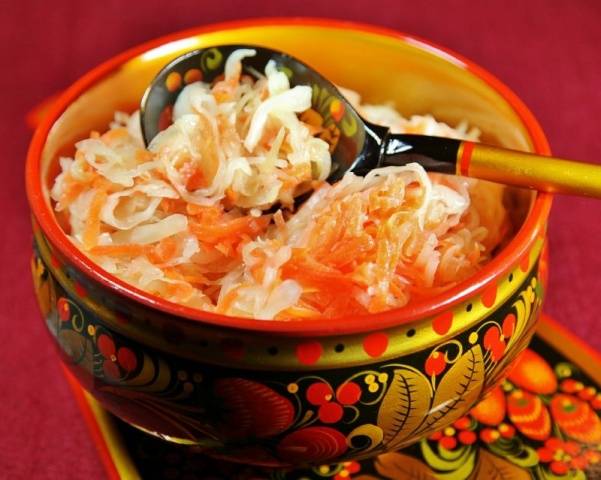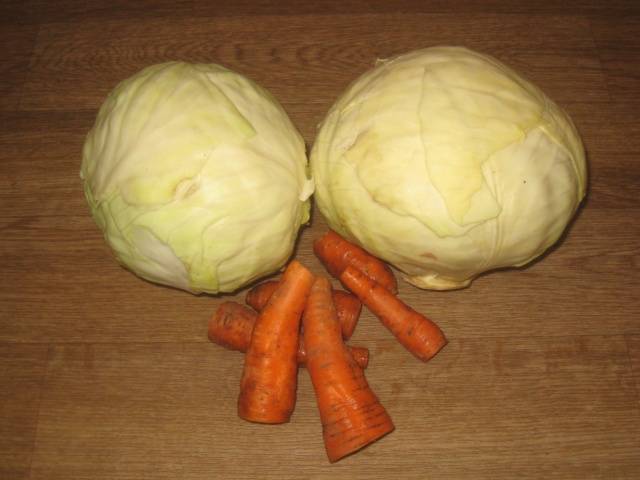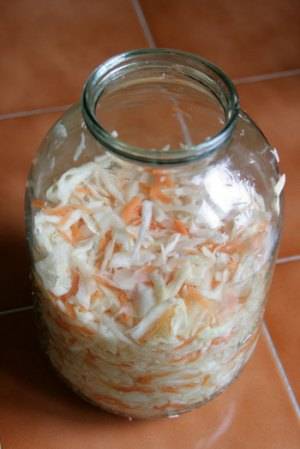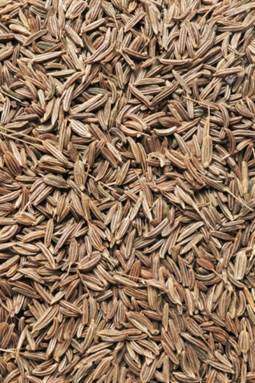Content
It would be historically incorrect to call sauerkraut a truly Russian dish. The Chinese learned to ferment this product long before the Russians. But we have been using it for so long that delicious pickling has become a national dish. The benefits of it are great, but, unfortunately, not everyone can eat it. The reason for this is the large amount of salt used for fermentation. An excellent way out - Sauerkraut without salt. The composition of such a product usually includes only cabbage and carrots, sometimes water is added to it. Such sauerkraut without sugar is being prepared. You can add spices, dill or caraway seeds to it, some use celery juice. There are a lot of recipes for such blanks.
The main difficulty in pickling cabbage without salt is to protect the product from spoilage. Therefore, vegetables for cooking are not only washed, but also thoroughly dried, and all dishes and knives are scalded with boiling water. If necessary, add water, it is taken only boiled.
Recipe for fermentation without salt and adding water
This recipe describes a classic fermentation, in which nothing but cabbage heads and carrots are added.
For 3 kg of cabbage, you need 0.5 kg of carrots.
We shred the heads of cabbage, put them in a basin, mnem well. Add the grated carrots, mix, place in a bowl, in which the fermentation will take place. Vegetables need to be tamped well.
As soon as the vegetables are completely covered with juice, we change the load to a lighter one.
The fermentation process takes place very quickly. After 2-3 days, the cabbage is fermented and ready to eat. You need to store it only in the refrigerator, as fermented in this way can easily deteriorate.
Fermentation without salt with the addition of water
The product prepared according to this recipe is tasty and healthy, but it cannot be stored for a long time. Therefore, we will not ferment a lot of it right away.
Only one carrot is required for half a cabbage head. Shred cabbage not too finely, add grated carrots. You do not need to crush or grind it. We transfer vegetables to a jar. They should fill it about halfway. We put a cabbage leaf on top, fill it with boiled or filtered water, install the load.
It is necessary to carefully monitor the water level, add it if necessary. Vegetables must be completely covered with water. Sauerkraut without salt is ready in 3-4 days. It is transferred to the refrigerator, where it is stored.
Pickling without salt with spices
This recipe does not even contain carrots, but there are seeds of herbs and crushed peppers. The taste of such sauerkraut will be brighter, and the seeds of dill, caraway and celery will enrich it with vitamins and useful minerals.
To ferment it you will need:
- 4.5 kg of cabbage heads;
- 2 tbsp. tablespoons of caraway seeds, celery, dill and crushed peppercorns.
Mix seeds and pepper, crushed in a mortar, with chopped cabbage. Set aside the sixth part and grind well until the juice is released. We send the grated vegetable back. We shift the fermentation to jars, tamping well. We put glass bottles with water on it, which will act as a load. If the fermentation is not covered with juice, add pure water.After 4-5 days, the finished product is transferred to the refrigerator.
There are recipes for fermentation, which is carried out in two stages. First, the brine is prepared, and then the cabbage is fermented in it. The brine can be reused.
Pickling in brine
First, prepare the brine. To do this, ferment the cabbage without salt in the usual way. From the finished fermentation, in the future, we will use only the resulting brine. This will require:
- 1 medium sized head of cabbage;
- garlic - 5 cloves;
- a pinch of ground red pepper;
- cumin to taste.
Cooking the brine
Mix chopped cabbage with chopped garlic, pepper, caraway seeds. We transfer it to a container in which we will ferment it, crush it a little, fill it with boiled water. We put the load on top, let it ferment for 3-4 days. The fermentation temperature is at least 22 degrees. We have fermented vegetables, of which we will only use brine.
Pour the finished brine into another dish, filter it well, squeeze the fermented vegetables there and throw it away, it is no longer needed. Next, we ferment another cabbage already in the prepared brine.
Pickling
For this you will need:
- ready-made brine;
- cabbage heads;
- carrot.
Shred the heads of cabbage, rub the carrots. We mix vegetables in a bowl in which we will ferment it.
Vegetables must be well compacted and filled with prepared brine. Put the lid and load on top. After 2 days, we pierce the pickling with a wooden stick and put it out in the cold. The product is ready in 2-3 days. After the cabbage is eaten, the brine can be used for a new batch. If it is not enough for a new starter culture, you can add boiled water.
Heads of cabbage fermented in this way are served with vegetable oil and onions. You can sprinkle the dish with chopped herbs. If it seems too sour, add a little sugar.
Conclusion
Cabbage fermented according to such recipes differs from salted cabbage. It can only be stored in the refrigerator, since the main preservative is no salt in it. It is softer than salty and does not crunch so much, but this does not make it less tasty. But such a product can be eaten by almost everyone.
















